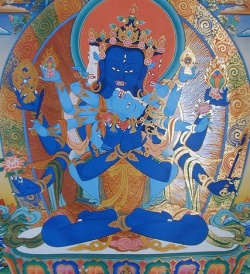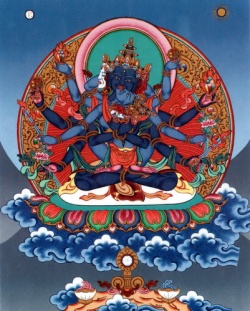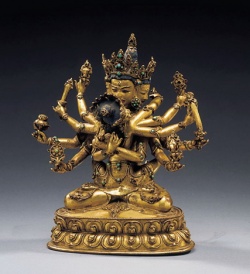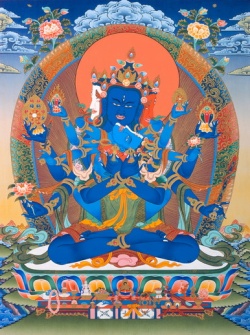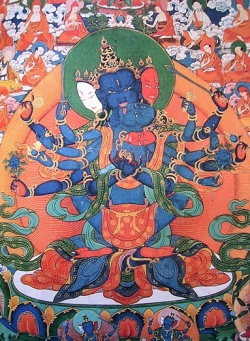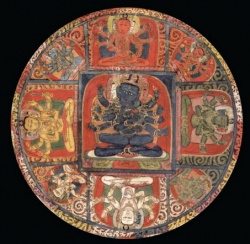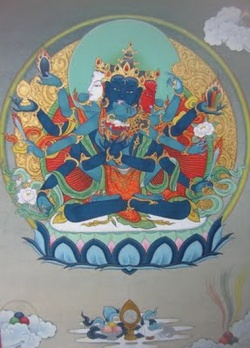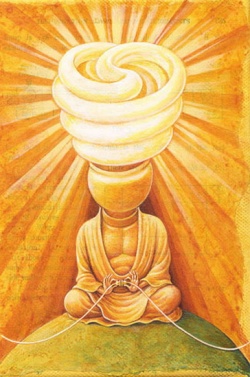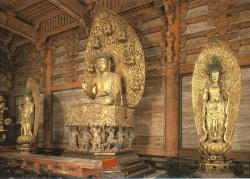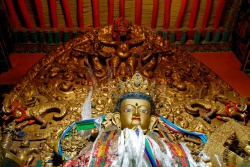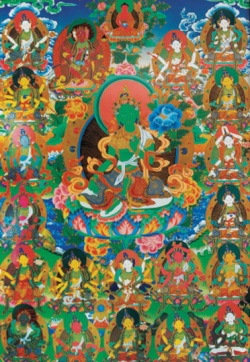History and Nature of The Collected Tantras of the Ancients
Author: David Germano (University of Virginia), March 25, 2002.
Tibetan Buddhism is a culture of the Text, or accurately, a culture of plural texts in translation. The cult of texts in Tibet is reflected not only in the massive canons of translated texts and equally massive collections of indigenous literature, but also in the Tibetan adaptation of the Buddhist textual cult of texts as sacred objects, texts as amulets, texts as magical agents and so on. However, this culture of texts was quite different from its Indian precedents in at least one way, namely the focus on translations. Since Buddhism had its inception in India, but was translated in a very self-conscious process from quite distinct languages into the Tibetan language, translation was a high profile phenomena in Tibetan Buddhism from its start right into the present. Buddhism had two major inceptions in Tibet, and both were driven by a massive influx of foreign texts being translated into Tibetan: the former in the eighth and ninth centuries came to be called the “earlier transmission” and the latter in the tenth through fourteenth centuries came to be called the “later transmission.”
By the fourteenth century, this massive amount of translated Buddhist scripture was collected and redacted into two huge collections, each totaling over one hundred volumes apiece. These scriptures constituted important items of worship in and of themselves, as well as constituting the fount of indigenous Tibetan Buddhist literature. The first collection contained only texts attributed to various transcendental authors – that is, Buddhas – and was titled The Translations of the Buddhas’ Own Precepts (Kangyur, bka’ ’gyur). The second collection contained only texts attributed to Indian masters, who were merely human, and was titled The Translations of the Treatises (Tengyur, bstan ’gyur) of miscellaneous authorship. The criteria for inclusion in the canon was basically that that the text in question was a direct translation of an original Indic manuscript. Proponents of these canons thus put them forward as the embodiment of the great cultural process by which Tibetans took the full range of Buddhist scripture and rendered it carefully and precisely into their own language, thereby achieving the impressive feat of transplanting Indian Buddhist thought, narrative and rituals in the high plains of Tibet.
However, there is another side to the grand cultural narrative, and it is revealed in precisely the texts claiming to be translations which were excluded from this great bipartite canon. There were groups of Tibetan Buddhists claiming to descend from the earlier transmission who has massive amounts of supposed translations from Indic sources dating to that period, but which had been rejected by the “later transmission” editors of the canons. These texts were mostly tantric in character, that is, they dated from the final period of Indian Buddhism marked by elaborate ritual and yogic systems that were highly visual in orientation, strongly antinomian rhetoric, and an emphasis on the human body. In response to this exclusion, these Buddhists edited their own canon of this ancient tantric literature supposedly in translation, which they entitled The Collected Tantras of the Ancients (Nyingma Gyübum, rnying ma rgyud ’bum; abbr. NGB). This canon has to date been little studied or understood by contemporary scholars. Like its more famous counterparts, it exists in a variety of editions which are generally similar, but often diverge considerably in content and organization.
In trying to understand this canon, it is essential to understand the history of its formation and compilation, as well as the nature of the texts it includes. We can begin with questions: what texts are included, and not included within The Collected Tantras of the Ancient? Functionally speaking, what type of canon is it? What was the motivation and agenda of the original editors? How are the individual texts organized and grouped within it? What is the relationship between the different editions of this canon?
Before proceeding deeper, we should reflect briefly on the nature of a canon. A canon is often a compilation of heterogeneous materials belonging to different authorial hands and different temporal periods. In addition, religious canons often involve texts attributed to divine voices or inspiration rather than the actual person who actually produced the text. In a Buddhist context, these divine voices are the various Buddhas inhabiting the cosmos. In addition, texts are often attributed to much earlier saints in order to gain legitimacy. In a Buddhist context, reincarnation raises additional problems, since people might claim to be now revealing texts they authored in previous lifetimes, or received from famous saints in previous lifetimes. This results in complicated questions of authorship. Religious canons, and in particular Buddhist canons, can thus be quite complicated in terms of identifying the “author.” Modern notions of “authorship” are just not adequate with their assumptions of a single author producing a stably defined text with his/her name stamped on it. Instead we must identify a entire set of figures in some contexts including “divine author,” “original redactor,” “concealer,” “revealer,” and so forth, each of whom may have had a hand in the actual shape of the received text. We must also be sensitive to how “reincarnation” or notions of inspiration can blur historical differences between figures involved in this process. We are thus dealing with this problem by not simply documenting the “author,” but documenting every single author involved in this process utilizing traditional nomenclature.
Thus what we find on the underside of the Tibetan translation project, and its canonizing counterparts, is a very diverse range of phenomena such as Indians producing texts in Tibet on the behalf of Tibetans, Tibetans writing with visionary inspiration from Buddhas, Tibetans writing with claims of past life reincarnational copyrights, and so forth. The Collected Tantras of the Ancients in particular constitutes a hybrid canon of genuine translations, and visionary translations, otherwise known in the West as apocrypha. Such a canon raises interesting questions of the nature of translation, authorship, readership, and editing. It may be useful to speak of visionary translation, visionary authorship, visionary readership, and visionary editing within the broader context of a visionary canon marked by visions, reincarnations of past saints, and emanations/incarnations of past, present and future Buddhas. In this way we can bibliographically and interpretatively acknowledge the tradition’s own self-understanding and self-representation, but also make useful distinctions with more conventional notions of translation, authorship, readership and editing that were as familiar to Tibetans as they were to Westerners.
With these considerations in mind, we will proceed to survey relevant issues concerning The Collected Tantras of the Ancients in relation to the mainstream twofold canon of translated Buddhist scriptures in Tibet. This survey will have two parts: Background and Editions.
I. Background
It is necessary to understand background concerning (i) canons in Tibet, (ii) doxographical category of texts, (ii) the different types of texts in relationship to original authorship, (iii) category of Buddha-voiced texts, (iv) and the different types of texts in relationship to public transmission.
1. Canons
There are many “canons” of scriptural literature in Tibetan Buddhism, but the most normative reflects various editions of a twofold canon known as Kangyur (bka’ ’gyur) and Tengyur (bstan ’gyur). These were attempts to collect together all the “valid” translations into Tibetan of “authentic” Indian Buddhist literature of all types. Thus the canon was defined as containing translations of mostly originally Indic texts. The creation of these canons really got underway in the fourteenth century, but there were important precursors in proto-canonical formations.
Issues of “validity” and “authenticity” were dominant concerns – at least rhetorically – of the editors in deciding what individual texts to include and exclude from the collection. They were aiming to be comprehensive, but only if the texts in questions were considered to be translations of works by valid Indian authors, or Buddha-authored texts revealed in India. Mostly importantly, the editors belonged to the “new” (sarma, nyinggsar ma) schools of Tibetan Buddhism, and they attacked the “old” (nyingma, rnying ma) school in particular as circulating many spurious translations. They excluded these from the canon by claiming that either they were written by non-Tibetans who were not proper Buddhist figures, or they were actually not translations at all, but rather indigenous Tibetan compositions. The massive amounts of literature belonging to the “Bon” school of Tibetan religion weren’t even considered at all for inclusion, because they were considered to be non-Buddhist.
The Bon in response during the same time period (fourteenth century) or only shortly afterwards – the early history of their proto-canonical formations is still unclear – formed their own closely parallel two-tracked canon with similar names. The Nyingma however, also in instead appeared to accept the Kangyur and Tengyur as such. Instead, they produced a supplementary canon of texts they felt had been improperly excluded of their own traditions: The Collected Tantras of the Ancients. This was thus partially in response to the consolidation of the Kangyur and Tengyur, though it was also done on the basis of earlier independent redactions of these types of materials.
2. Doxographical category
In general, both Indian and Tibetan Buddhism tended to classify both Buddha-authored and human-authored texts as belonging to particular doctrinal-praxis systems. These systems were then often ranked in a vertical nested hierarchy of “lower” and “higher” systems of thought and practice. Particularly important is how Buddha-voiced texts are generally divided into two types known as “sūtras” (mdo) and “tantras” (rgyud), and the corresponding exegetical material is divided similarly. While historically these two classifications blur into each other, in broad terms, they are marked by quite distinct literary qualities, thematic contents, and systems of practice.
When we turn to the Kangyur and Tengyur, we find that these canons are structured by grouping together sets of texts under a variety of rubrics. These rubrics are of different types. They include categories of literature devoted to a particular theme – such as sūtras on monastic discipline (vinaya) – groups of historically interlinked texts that constitute something like an anthology (avataṁsaka sūtra), and groups of texts constituting a specific school of thought (yogācāra). In both canons, “tantras” (rgyud) are set forth as a category in and of themselves, and apart from the “sūtras.” The former are clearly ranked as higher to the latter. Thus the groupings of texts is doxographical, literary and otherwise in nature.
The Collected Tantras of the Ancients only contains tantras and tantric exegetical literature. It contains no sūtras or non-tantric exegetical literature. It thus appears the original editors of The Collected Tantras of the Ancients were concerned to provide a canonical home to their own distinctive tantric literature which had been excluded from the Kangyur and Tengyur. They had no quarrel with the canonical status of the materials in the latter canon, but felt that The Collected Tantras of the Ancients traditions represented the “highest” of Buddhist traditions in addition rather than in place of the materials found in the Kangyur and Tengyur. The reasons are clear for why sūtras and sūtra-related literature was not an issue relates to temporal issues (see below). For one, it appears that apocrypha in Tibet was generally tantric in character.
The Collected Tantras of the Ancient’s texts also are organized into distinct groups within the canon. The overarching organization is tripartite, and is based upon three distinct tantric systems: Atiyoga, Anuyoga and Mahāyoga. However, the internal organizations of each of these three are based on various types of considerations, including the doxographical. An example of doxographical classifications are the subdivisions of Atiyoga such as Citi (sPyi ti), a literary classification is the Mayājāla group within Mahāyoga, and also within Mahāyoga, the 8 divisions of the “Eight Proclamation Deities” (bka’ brgyad) offers an instance of classifying texts based on the deities they are centered on.
An important sub-issue in this context is the nature of these doxographical groupings. At times these groupings are natural classifications that identify a group of texts which explicitly self-refer to themselves as belonging to the rubric in question. They also refer to common themes, vocabulary, cite each other, and so forth. However, some groupings appear to be later and higher artificial classifications that obscure as much as they reveal. In these cases, the texts often seem to have no sense of belonging to such a rubric, or with each other. In addition, the individual texts often seem highly diverse, from quite distinct temporal periods, authorial hands, and so forth. It is not unlikely that the canonical schemes themselves were important factors in the retroactive creation of traditions for these texts. Indeed the creation of canons itself creates the impetus to clearly delineate between texts as belonging, or not belonging within particular rubrics of classification. Whereas before texts could just exist as a “tantra” or just “Atiyoga,” it now became necessary for each text to be identified as belonging to a particular subclass, an artificial necessity that led to contrived classifications producing an artificial unity without strong historical basis.
3. Authorship
In terms of authorship, we can discriminate between three principles of differences that were important to editors of these canons in Tibet: the being, temporality and ethnicity of the author in question.
i. The “being” of an author signifies the strong difference between a text authored by a Buddha, and a text authored by a”historical” human. A Buddha could be the “historical” Shakyamuni Buddha located in our own immediate past, or it could be a Buddha from a far distant time or world. Their texts are always presented as transcripts with narrative frames of orally delivered lectures. However, human authors are usual actual people located in our geograpical and temporal contexts. Their texts are usually presented as originally written texts. Thus we have divine oral texts, and human graphic texts. The functional difference is that the Buddha-authored texts are considered to have absolute authority, while the human-authored texts are considered theoretically to have lesser authority. Finally, the oral divine texts often are also partially, or fully, spoken by similar divine, “mythic” figures such as Bodhisattvas, Dakinis, Gods, Goddesses, and so forth.
Thus the standard twofold canons of Tibetan translations of Indian Buddhist literature are defined as containing translations of mostly originally Indic texts. Texts are divided up into the two canons on the basis of the “being” of the authors: the Buddha-authored texts are redacted as the Kangyur and the human-authored texts are redacted as the Tengyur.
On the point, The Collected Tantras of the Ancients is often thought to correspond to the Kangyur – indeed, its very title refers to it being a collection of “tantras” (rgyud), which by definition are Buddha-authored. However, in fact The Collected Tantras of the Ancients includes Buddha-authored and human-authored texts, and thus is more like a blend of Kangyur and Tengyur. However, it is clear the original editors were not trying to be comprehensive in terms of including all rnying rgyud and exegetical material. Thus important questions pertain as to issues of selectivity exercised by editors in including some texts and excluding other texts in The Collected Tantras of the Ancients.
ii. The “temporality” of an author relates to the history of how Buddhism was transmitted into Tibet. This transmission is usually talked about as having taken place in two phases: the “earlier transmission” (snga dar) and the “later transmission” (phyi dar). The earlier transmission was the first transmission of Buddhism into Tibet that began with the patronage of the Tibetan empire (c. 700-c. 842), and then continued more sporadically after the empire’s collapse (c. 843-c. 1000). The later transmission then began with the revival of economics after that collapse (c. 1000) and continued until the influx of Buddhism from other countries and consequent translation activity began to die down (c. 14th century).
The “earlier transmission” first involved a large scale official sponsored translation project, but then after the empire’s collapse continued on in unofficial and decentered processes. It appears during the first phase, that the focus of translation was more centered on Buddha-voiced materials than on human-authored exegetical material; the focus was also somewhat more on sūtras rather than tantras. However, after the collapse of the empire, the focus turned towards tantras. The content and orientation of tantric Buddhism seemed far more suited to the decentralized society that ensued. In addition, in the absence of centralized authority, it appears that a large body of literature was produced in Tibet which at some point came to be represented as translations of non-Tibetan originals, but in fact was not in any conventional sense of the word. It is unclear to what exent the original texts in any given case claimed originally to be translations, or to what extent such claims were tacked on via colophons by later editors rather than the original authors.
This resulted in the later controversies over some element of the “earlier transmissions” – while much of it was accepted without reservation into the Kangyur and Tengyur, much of the tantric component was rejected (fairly or not fairly) on the assumption it original Tibetan literature and hence were not authentic. While it appears there was a certain degree of ongoing translation between the mid 9th and mid 10th centuries, there are clear signs of its limits even pertaining to tantric tradition. The dominant tantric traditions emerging in India during that time period are not part of the legacy of these groups, and hence appear not to have been translated until after the tenth century by other Tibetan groups. However, it could be argued that some of these issues relate to the geographical base of some of these traditions in India. In other words, prior to the emergence of the “later transmission” and after the breakup of the Tibetan empire, it may have been that extensive travels to India for the purpose of scholarship were minimal and instead the focus was within Tibet. Thus translations may have stemmed from Indians in Tibet, or border regions, or Tibetans in border regions. It may have been that these regions were not those were the yogini tantras thrived which were so central to the later trasmission.
Finally, after the close of the tenth century, these Tibetan groups no longer had any interest in “translation” per se. The subsequent Buddha-voiced literature and Indian-authored literature these circles produced after the tenth century claimed to be translations from Sanskrit and other languages, but they claimed to have been produced as translations before the tenth century. In other words, they produced new “translations,” but always claimed they originally dated back to the empire or shortly thereafter. At times the lack of public circulation was explained via a visionary tradition of concealment and revealment, and at other times it appears texts were just introduced into circulation without explanation. It remains unclear in many cases whether the visionary claims were original to the text’s production, or whether they were added later via colophon by editors. It seems clear they were aware of and studying new Indic materials after the tenth century, but they were not interested in pursuing this in terms of “translations,” and instead recreated these influences in new traditions put forward as ancient texts. Tibetan groups who adhered to these “early transmissions” and forsook conventional “translation” from the late tenth century onwards were thus known as the “ancients” (rnying ma).
The “later transmission” then dates to the close of the tenth century. These figures were part of an economic revival in Tibet. They saw two sets of problems with the earlier transmissions: (i) there were many new texts in India that had not been translated by the earlier transmission and (ii) many of the older translations required updating and modification because of inadeqeuacies and/or anachronisms. Its necessary to look carefully at the rhetoric concerning translations during the eleventh and twelvth centuries. It appears the later transmission was more focused on exegetical material than Buddha-voiced material, though it also translated a large body of new tantras that had emerged in India after the 9th century. It should be noted that it remains unclear as to what extent some prominent later translators may have just been changing translator colophons to old translatons with only minimal or no alteration. The later transmission seems to have been spurred by two factors: the economic revival of Tibet, and the perseuction of Buddhism in India which led to Buddhist teachers being receptive to foreign Tibetans continuing their traditions abroad, as well as even to travelling to the far distant lands of Tibet. Groups who embraced these new translations and thus had their historical inception from the end of the tenth century onwards came overall to be known as the “new ones” (gsar ma). These translations largely died out by the fourteenth century as the the Muslim invasions largely eradicated Buddhism in India and Central Asia, and thus Tibetans began to turn inwards.
It is thus clear why the Kangyur and Tengyur were first redacted in the fourteenth century – the translations were coming to a close, Buddhist neighbors were fading out, and Tibetan culture overall was going through a period of systematizatin and consolidation. It was thus a time of taking inventory, sectarian consolidation, and the production of canons. It was a time of closure on many levels. These two canons consist of translations of both “earlier transmission” and “later trransmission” periods.
The Collected Tantras of the Ancients is thus literally the “collected tantras” (rgyud ’bum) of the ancients (rnying ma). It reflects an attempt to gather together all tantras and human-authored tantric texts whose revelation or composition dates back to before the eleventh century. Its editors were probably spurred by the exclusion of these texts from the Kangyur and Tengyur, but also were continuing earlier efforts to gather together these texts into larger collections for preservation, merit-making, and transmission. They were not concerned with sūtras and sūtra-basis exegetical literature because after 842 it was tantric literature that proliferated, and which became a major genre of Tibetan literature output. Thus it was tantric literature that both constituted this class of apocryphal literature with dubious claims to represent translations from Indic originals, and which constituted the chief concerns of the Nyingma. Thus all the literature which these groups saw as “higher” was tantric in character, and The Collected Tantras of the Ancients was thus a presentation of their most valued textual traditions.
Clearly most of the factors behind what texts were excluded or included in The Collected Tantras of the Ancients were pragmatic. It was redacted in the fifteenth century in response to exclusion of orthodox canons. The editors thus left out most of the texts which were accepted by the Kangyur and Tengyur, even if they did represent earlier transmission translations of tantric materials. As it happened, it was precisely the “higher” tantric traditions which had been excluded, so that The Collected Tantras of the Ancients consisted of the Nyingma’s highest traditions and excluded the lower tantric traditions. It also seems that the focus of the editors was to collect all tantras authored by Buddhas, but only collect shorter exegetical materials on those same tantras. They thus left out lengthy human-authored materials, and also in general left out directly exegesis of single tantras. It may be that the editors also avoided texts that were already redacted in other stable literary collections, especially the great collections of “treasures” (Terma) by individual treasure-finders (see below). For example, even “tantras” redacted within treasure cycles are frequently not included within The Collected Tantras of the Ancients. It may thus be that the precise material redacted here is in part a function of the editorial desire for preservation of materials otherwise in danger of being lost because of the lack of a broader literary home and tradition of transmission. In addition, the editors paralled the bKa ’gyur and Tengyur by allowing only non-Tibetan authored texts to be included (see below).
What were the principles of authenticity that The Collected Tantras of the Ancients editors used to include and exclude texts? This is hard to judge given our limited information. It may well be that regional considerations of the earlier editors played an important role in deciding the validity or importance of particular traditions. Further research into earlier editors’ biographical and other writings may shed light on these considerations.
Finally, it is important to note note that The Collected Tantras of the Ancients editions overall appear to be pre-sixteenth century traditions. It was thus in general a closed canon based on temporal considerations. In other words, further tantras and Indic-authored exegetical materials continued to be brought to light from the sixteenth century onwards just as before, but they were no longer redacted within The Collected Tantras of the Ancients. There is no theoretical justification for this division, but rather it seems it was simply the historical contingencies of the redaction of canons in the fourteenth century that led to this definitive closure taking place the next century. It may also be that Ratna gling pa’s fifteenth century editorial activities were particularly important for reasons as yet unclear. For example, it may be that he was particularly successful in disseminating his edition, or his efforts at collection were particularly extensive, or finally that he was particularly successful at establishing an institutional basis for ongoing support, dissemination and transmission of his edition of The Collected Tantras of the Ancients. It may also be that the explosing of Nyingma “treasure” literature from the fourteenth century onwards made it untenable to think of creating a single canon to contain all of them, such that The Collected Tantras of the Ancients was considered closed.
Finally, it should be noted that it may be that ongoing redactions of The Collected Tantras of the Ancients – certainly from earlier periods, but perhaps also after the sixteenth century – most likely included local materials not found in other editions. Our current possession of only a few editions makes this question difficult to appraise. But clearly the collection of texts was an ongoing important activitiy in the redaction of each edition, as evidenced by the supplementary volumes added to the Degé and Kyidrong editions from texts only located after the initial redaction of the edition.
iii. The “ethnicity” of authors concerns whether the author is Tibetan, or whether the text in question is a Tibetan translation of a text originally authored by an Indian. With the rise of the later dissemination, the consequent emphasis on translation of Indic texts and lineages, and the creation of the Kangyur/Tengyur – a canon which not simply translated, but which included translation as a central aspect of its sanctity – the non-Tibetan character of texts’ authorship came to be viewed as a hallmark of authenticity. This appears to have been an important factor in the rise of the “treasure” cult and the Nyingma’s tendency to produce its new literature in the authorial voices of eighth and ninth century Indians, rather than in their own Tibetan voices.
4. Transmission
Regardless of whether the text in question was Buddha-authored or human-authored, Nyingma authors classify texts as “continuously transmitted precepts” (bka’ ma, “Kama”) or “treasures” (gter ma, “Terma”) The basic principle of distinction concerned the way in which the texts in question claim to have been transmitted in Tibet following their supposed translation into Tibetan from their original source language. One category of texts claims to have been concealed for a period of time following translation, such that their circulation was at some point interrupted via concealment and then later re-revealed (Terma); the other category claims to be texts that were transmitted without intervening concealment and re-revelation (Kama). One important qualification must be introduced immediately, namely that the issue of concealment and continuity applies only to Tibet, not India. In other words, if a text was continuously transmitted in Tibet from the point it was translated into Tibetan, it is classified as Kama; if it was instead translated and then concealed in Tibet, it is Terma. Thus a Kama text may very well have been concealed and re-revealed in India, but this is only pertinent for its classification to the degree that it transpires on Tibetan soil. A simplistic assumption by some is that in terms of Nyingma tantras and Indic tantric literature, Kama represent genuine translations of Indic originals and Terma represents spurious Tibetan compositions only claiming to be translations. This is clearly inadequate on both fronts: the Kama texts claiming to be translations are at times clearly original Tibetan compositions and the Terma claiming to be translations are at times genuine translations or adaptations of genuine translations.
The situation is somewhat more complex than this. Firstly, presumably some texts that claim, or are claimed to be, Kama, in fact have be apocryphal and hence only first emerged long after the date from which it was supposed to be continuously transmitted. It may also be that in some cases texts that were originally put forward as Terma as documented by colophons or associated documents were later re-cast as Kama. Conversely, it may be that the classification of some texts as Terma may indeed be retroactive re-casting of texts which were not originally identified as such. It seems likely that many of these texts were initially circulated as anonymous texts, both in terms of their authorship and their transmission. This greatly complicates issues. When combined with the multiple figures involved in a Terma text – author, concealer, revealer and so on – the situation becomes quite problematic.
The closed and early nature of The Collected Tantras of the Ancients has often led to people assuming it is Kama, which is what distinguishes it from the other great Terma collections. But this is clearly erroneous, since The Collected Tantras of the Ancients is a complex combination of Kama and Terma texts. I believe its early editors were attempting to gather together all Kama versions of the relevant traditions’ tantras and exegetical material, but only a preponderance of Terma versions and exegetical material.
Finally, it should be noted that the term Kama in Nyingma literature is an ambiguous one. On the hand it can signify all literature transmitted without break in Tibet – Buddha-voiced or human-authored, Indic or Tibetan, Sarma or Nyingma. But functionally, at a certain point it began to be used to refer to a particular redaction of largely Tibetan authored Nyingma literature pertaining to Atiyoga, Anuyoga and Mahāyoga tantric traditions. While this was initially a relatively limited collection, in the latter half of the twentieth century it has been markedly expanded until has become something like a true complement to The Collected Tantras of the Ancients for Tibetan-authored literature on these three tantric traditions. Yet, like The Collected Tantras of the Ancients, it also is not comprehensive in any sense, and its editors seem to be guided by the same pragmatic considerations that the original The Collected Tantras of the Ancients editors were: preservation of rare and fragile literature, and convenient packaging of scattered sources for its continuing transmission. II. Editions
When we turn to the history of particular editions of The Collected Tantras of the Ancients and their contents and organization, we are seriously hampered by the limited number of editions we now have access to and the lack of documentation of now lost editions. There have been three brief surveys of these issues: one by Dan Martin, and two by Franz-Karl Ehrhard. In short, there were early redactions about which we know almost nothing. It may be that The Collected Tantras of Vairocana (Bai ro’i rgyud ’bum) represents one such early redaction; it may also be that the “tantras of the ancients” (rnying rgyud) sections included in some versions of the Kangyur and Tengyur also reflect some version of earlier redactions. Clearly Ratna Lingpa Rat na gling pa, 1403-1478) was of fundamental importance with his edition of The Collected Tantras of the Ancients.
However, we know little about the contents and organization of these editions until the late 18th century editorial work by Jikme Lingpa (’Jigs med gling pa) for the Pema Öling (Pad ma ’od gling) manuscript edition, and its transformation a few decades later into the Degé (sDe dge) woodblock print edition by Katok Getsé (KaH thog dge rtse). Apparently this was the first woodblock print of The Collected Tantras of the Ancients ever to be produced, and with the prestige and dissemination power of the Degé publishing house behind it, it naturally became the dominant edition of The Collected Tantras of the Ancients. Prior to this, all editions had been manuscript in form, and hence unique copies. This also entailed that all dissemination of the edition entailed a complete recopying of the entire canon by hand, which naturally limited the extent of its dissemination. We possess catalogues (dkar chag) by Jikme Lingpa and Kathok Getse respectively for these two eighteenth century editions, and so the internal organization and its rationale is clearly documented (the two editions are quite similar). The Degé edition is precisely organized by its editors into a series of categories and subcategories. However, we do not know how this organizational scheme relates to earlier editions, especially the editorial work of Ratna Lingpa. Thus we cannot evaluate how innovative, or traditional, this scheme may be.
The Tingkye (gTing skyes) and Kyidrong (sKyid grong) editions are very close to the Degé in organizational schemes, and seem likely to derive from Degé in this regards. However, even if that was true, it could be the actual texts are not derived from Degé, but rather only their organization into groups. It could also be that the organization derives from pre-Degé editions which is influencing all three editions separately. The Tshamdrak (mTshams brag) edition is unique in that its sequencing and grouping of texts is quite different from Degé, and apparently reflects independent Bhutanese editorial traditions.
In summary, The Collected Tantras of the Ancients is a pre-sixteenth century compilation of translated materials from three distinct tantric traditions excluded from the mainstream Tibetan canon of Indian Buddhist translations. Its dating is clouded by the fact that while it is clearly a canon of materials that attained public circulation prior to the fifteenth century, its visionary and conventional “editors” claim that all its texts are pre-ninth century in origination, even if public circulation quite later.
